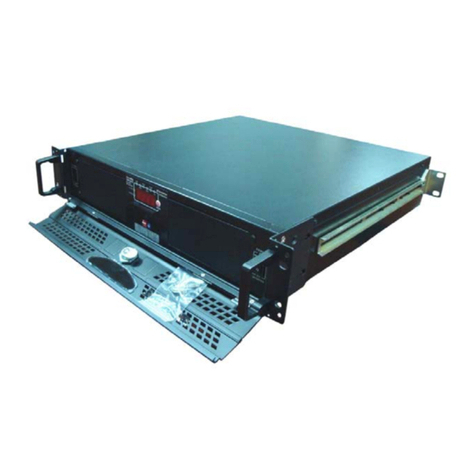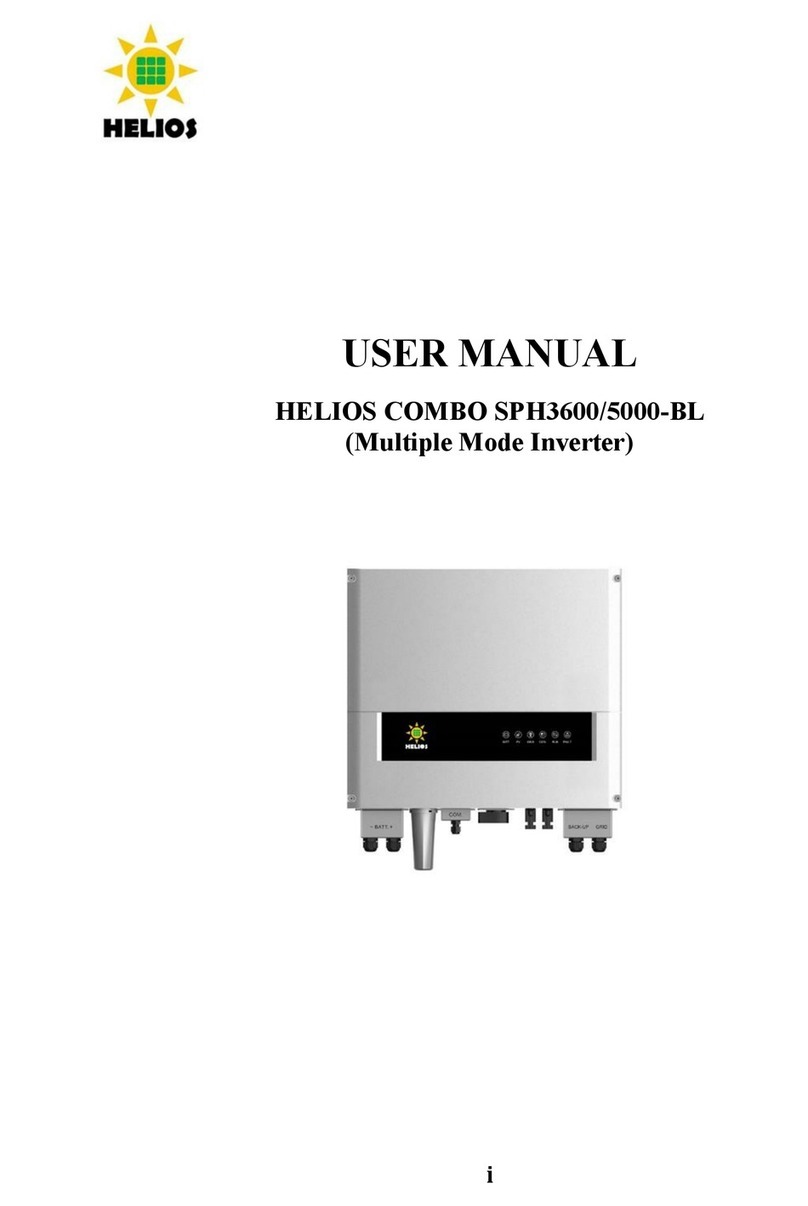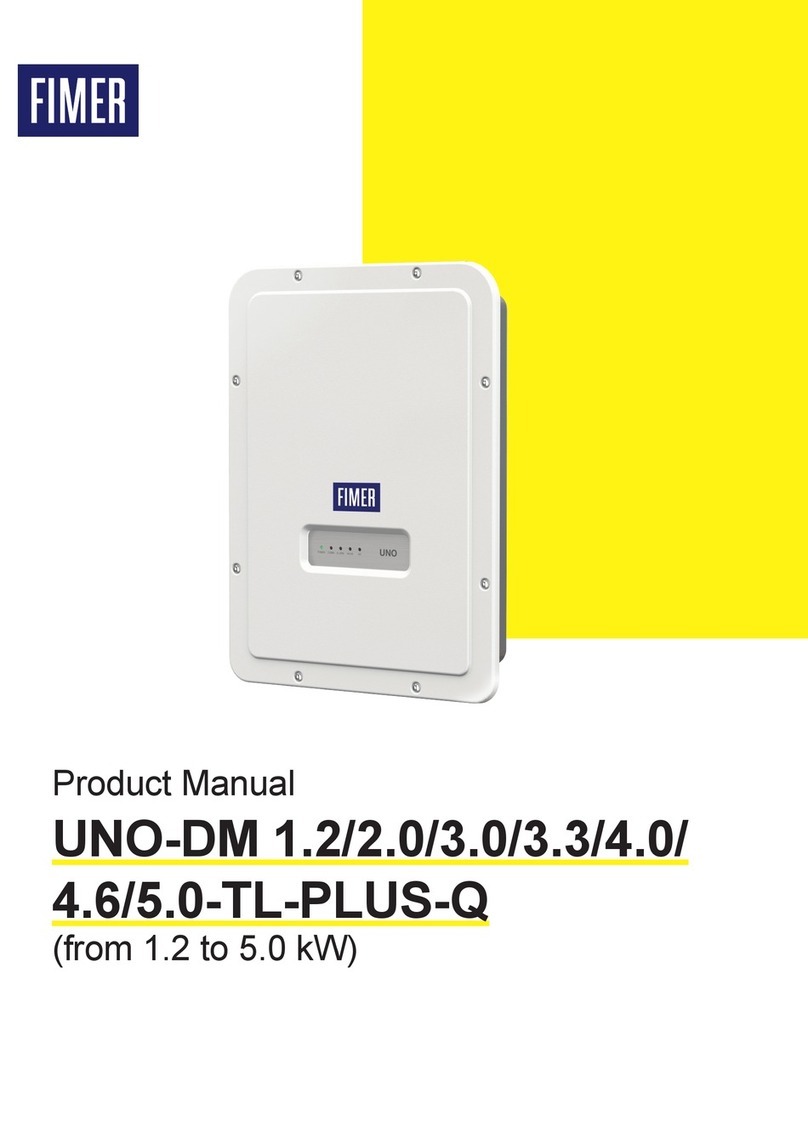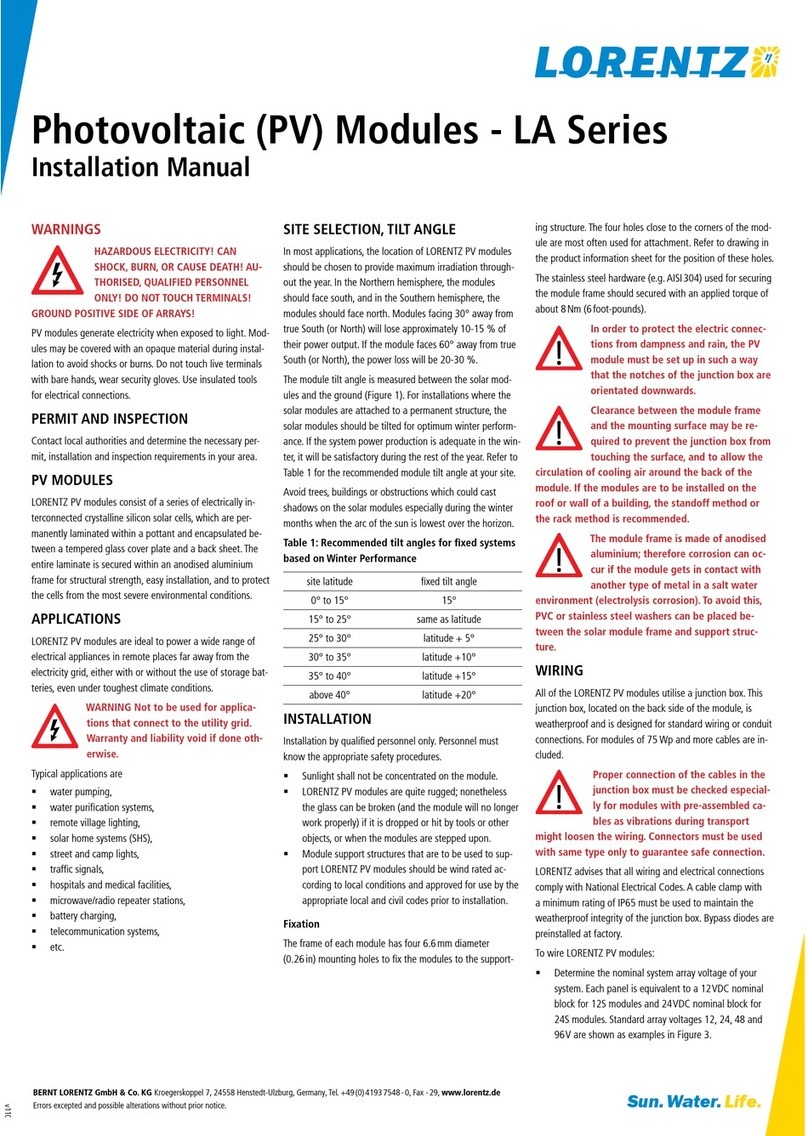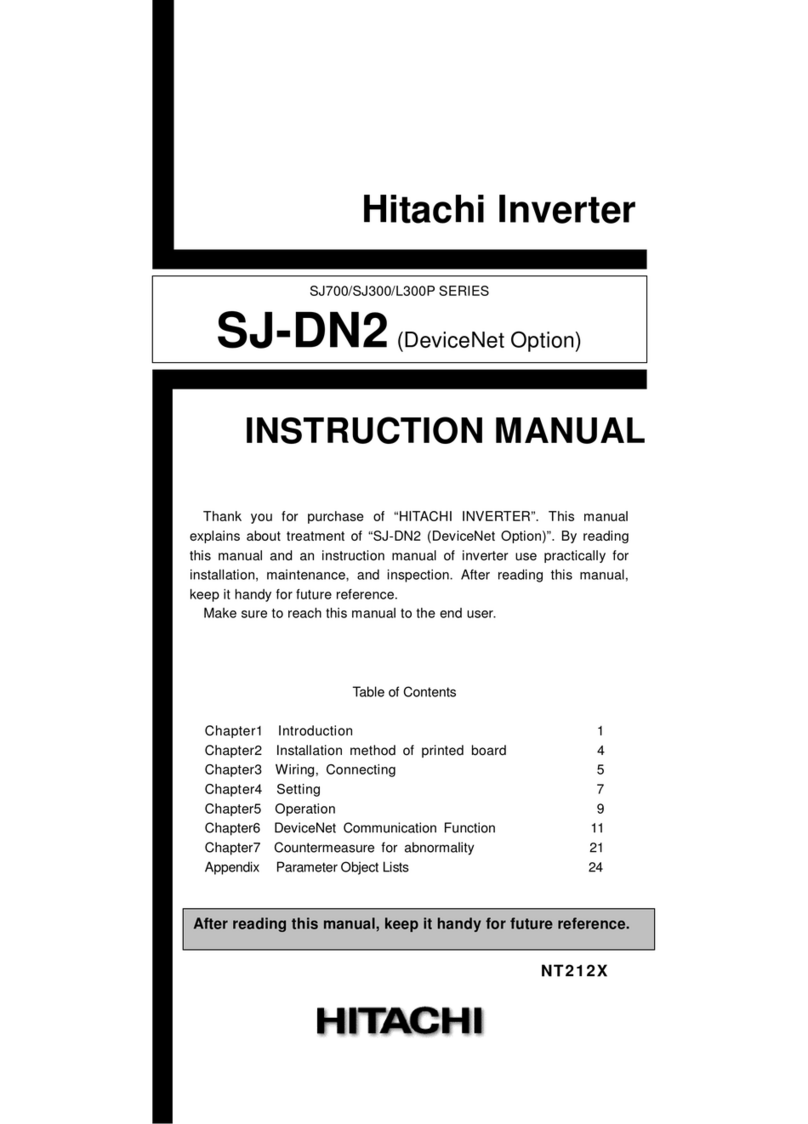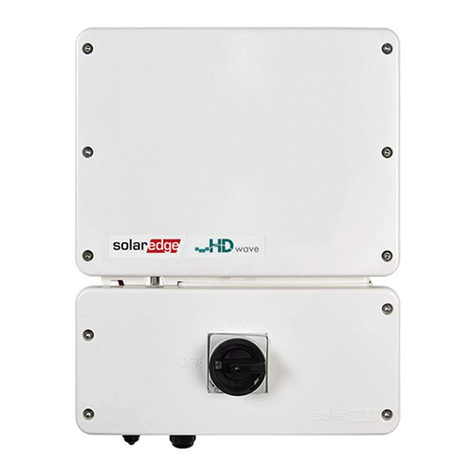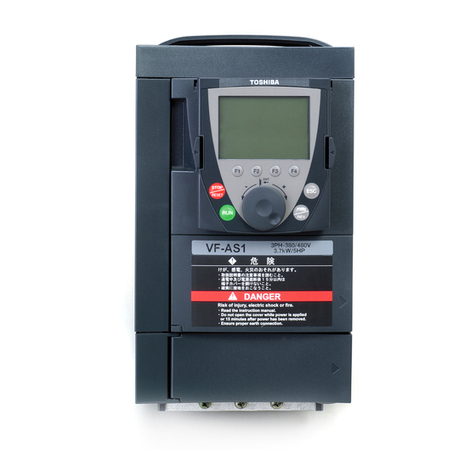Helios RM-PSW5KVA Series User manual

PureSineWaveInverter
50-PSW1105KVA/E
50-PSW2205KVA/E
2U x 19" rack mount
50-PSW5KVASeries
www.heliosps.com
Email - New Zealand: [email protected] - Australia: [email protected] - Asia & Middle East: [email protected]
REV (
22-05-2020
)
50-PSW245KVA/E
Instruction Manual
50-PSW485KVA/E

1
List of Contents
1 Features Page
1-1 Application 2
1-2 Electrical performance 3
1-3 Mechanical drawings 4
2 Introduction
2-1 Front panel operations 5
2-2 Rear panel operations 6
2-3 Installation 7
2-4 Quick hook up and testing 8
2-5 AC safety grounding 9
2-6 Making DC wiring connections 10
2-7 Inverter operation 11
2-8 Cooling fan working code 13
3 Maintenance 13
4 Troubleshootingguide 14
5 Warranty 15
6 Importantsafetystriations
6-1 General safety precautions 15
6-2 Precautions when working with batteries 16
7 Appendices A
7-1 Dip Switch 16
7-2 Tune VR 16
7-3 RS232 Protocol 17

2
1Features
n R Load Pure sine wave output (THD < 3%)
n By pass function
n Output frequency: 50 / 60Hz switch
n RS-232 interface / remote controls port / Wire connection to PC
n Wired Remote Control
n Loading controlled cooling fan
n Advanced microprocessor
n Protection: Input Undervoltage
Input Overvoltage
Overload
Short circuit
Low battery alarm
Over temperature
1-1 Utilities Application
l Power tools circular saws, drills, grinders, sanders, buffers, weed and hedge
trimmers, air compressors.
l Office equipment computers, printers, monitors, facsimile machines, scanner.
l Household items vacuum cleaners, fans, fluorescent and incandescent lights,
shavers, sewing machines,
l Kitchen appliances microwave ovens, refrigerators and freezers, coffee makers,
blenders, ice markers, toasters.
l Industrial equipment metal halide lamp, high pressure sodium lamp.
l Home entertainment electronics television, VCRs, video games, stereos, musical
instruments, satellite equipment.

3
1-2 Electrical Performance
Specification Model
Item RM-PSW
245KVA
RM-PSW
485KVA
RM-PSW
1105KVA
RM-PSW
2205KVA
RM-PSW
245KVAE
RM-PSW
485KVAE
RM-PSW
1105KVAE
RM-PSW
2205KVAE
Continuous Output Power
5000W
Maximum Output Power 5200W (3 mins)
Surge Rating 10000W
Input Voltage 24V 48V 110V 220V 24V 48V 110V 220V
Input Voltage Range 20-32
VDC
42-62
VDC
90-140
VDC
180-275
VDC
20-32
VDC
42-62
VDC
90-140
VDC
180-275
VDC
DC Input over voltage alarm
31VDC 61VDC 135VDC
270VDC
31VDC 61VDC 135VDC
270VDC
DC Input over voltage
shut-down 32VDC 62VDC 140VDC
275VDC
32VDC 62VDC 140VDC
275VDC
DC Input under voltage alarm
21VDC 43VDC 95VDC 185VDC
21VDC 43VDC 95VDC 185VDC
DC Input under voltage
shut-down 20VDC 42VDC 90VDC 180VDC
20VDC 42VDC 90VDC 180VDC
No load Current Draw 1.64A 0.82A 0.42A 0.24A 1.30A 0.68A 0.35A 0.18A
Output Voltage Adjustment
100 ~ 120V (Tune VR) 200~240V (Tune VR)
Frequency 50/60Hz 0.05%(Switch Selectable)
Peak Output Current 91A 45A
Efficiency (fullload) 85% 87% 90% 92% 90% 92% 94% 94%
StandbyCurrentDraw ≤1.5WPower Saving Mode
OutputWaveform RLoad Pure SineWave <3%TH
Protection Overload, Short Circuit, Reverse Polarity (fuse), Input Undervoltage, Input Overvoltage ,
Over Temperature.
Digital Display OVP, UVP, OTP, OLP, VAC, AMP, WATT, VDC, TEMP, Hz
Safety EN60950-1
Interface Control Unit RS-232C with Baud Rate 2400, 4800, 9600, 19200 (Switch Selectable)
Remote Control Unit Optional
AC Input 110V AC 220V AC
AC Frequency (50Hz ~ 60 Hz) ± 3% (50Hz ~ 60 Hz) ± 3%
Bypass 4~6ms 4~6ms
Operating Temperature
Range -20°C to 50°C
Storage Temperature Range
-30°C to 70°C
Dimensions 504(L) x 425(W) x 132(H)mm
Cooling Loading controlled cooling fan
Weight
19kgs

4
1-3 Mechanical Drawings

5
2
Introduction:
The power inverter series are the member of the most advanced line of mobile AC power systems
available.
To get the most out of the power inverter, it must be installed and used properly.
Please read the instructions in this manual before installing and using this model.
2-1
FrontPanel Operation:
2-1-1 Front view:
2-1-2 ON / OFF switch:
Please leave in the OFF position during installation.
2-1-3 Function Key
When sequentially push “Function Key”, it will display various status on the function
screen, Such as VAC, Amp, watts… and so on.
When malfunction is occurred, its display will be flashed on the screen.
2-1-4 AC outlet (Outlet sockets available):

6
2-2
RearPanel Operation:
2-2-1 Ventilation openings:
Do not obstruct, allow at least 3 inch for air flow.
2-2-2 AC input switch: This switch is to be operated by qualified personnel only.
2-2-3 Battery terminals:
Connect to 24V/48V/110V/220V battery or other 24V/48V/110V/220V power Source.
+】is positive, -】is negative. Reverse polarity connection will blow internal fuse
and may damage inverter permanently.
2-2-4 RS-232:
Connect to computer to remote control working status.
Alarm relay operation:
Voltage free contacts ( NO, COM, NC )
1)With normal dc supply ON and inverter output OK, and AC by pass supply available:
NC and COM is closed.
2)With normal dc supply ON and inverter output OK, and AC by pass supply not available:
NO and COM is closed.
3)Inverter shutdown due to: “OTP, OVP, UVP, OLP, short load"
NC and COM is closed.

7
WARNING!
Any damages caused by using incorrect RS232 cable will be
outside of our warranty scope. If you are not sure which one is
correct RS232 cable, please purchase the correct RS232 cable
from us directly.
2-2-5 Connect chassis ground terminal to earth using # 8 AWG wire.
WARNING!
Operation of the inverter without a proper ground, c
onnection may
result in an electrical safety hazard.
WARNING!
Shock Hazard. Before proceeding further, carefully check the
inverter is NOT connected to any batteries,
and that all wiring is
disconnected from any electrical
sources. Do not connect the
output terminals of the inverter to an incoming AC source.
2-3
Installation:
Where to install.
The power inverter should be installed in a location that meets the following requirements
2-3-1 Dry Do not allow water to drip or splash on the inverter.
2-3-2 Cool Ambient air temperature should be between -20 and 50 , the cooler the
better.
•See Appendix A for RS232 protocol

8
2-4 Quick hooking –upandtesting:
2-4-1 Unpack and inspect the power inverter, check to see that the power switch in the OFF
position.
2-4-2 Connect the cables to the DC input terminals on the rear panel of power inverter.
The red terminal is positive (+) and black terminal is negative (-).
Insert the cables into the terminals and tighten relative nut to clamp the wires securely.
WARNING!
You may observe a spark when you make this connection since
current may flow to charge capacitors in the power inverter.
Do not make this connection in the presence of flammable fumes.
Explosion or fire may result.
WARNING!
Make sure all the DC connections are tight (torque to 9-10 ft-lbs,
11.7-13Nm). Loose connections will overheat and could result in
a potential hazard.
2-3-3 Safe Do not install in a battery compartment or other areas where flammable
fumes may exist, such as fuel storage areas or engine compartments.
2-3-4 Ventilated Allow at least one inch of clearance around the inverter for air flow. Ensure
the ventilation openings on the rear and bottom of the unit are not obstructed.
2-3-5 Dust-free Do not install the Inverter in a dusty environments where are dust, wood
particles or other filings/shavings. The dust can be pulled into the unit when the cooling
fan is operating.
2-3-6 Close to batteries Avoid excessive cable lengths but do not install the Inverter in the
same compartment as batteries.
Use the recommended wire lengths and sizes (Ref. point 2-6).
Also do not mount the Inverter where it will be exposed to the gases produced by the
battery.
These gases are very corrosive and prolonged exposure will damage the Inverter.

9
2-4-3 Before proceeding further, carefully check that cable you have just connected negative
terminal of inverter to the negative output power source.
CAUTION!
Reverse polarity connection will blow a fuse in inverter and
may permanently damage the inverter.
Damage caused by reversing polarity connection is not
covered by our warranty.
2-4-4 Connect the cable from the negative terminal of the inverter to the negative
terminal of the power source. Make a secure connection.
WARNING!
You may observe a spark when you make this connection since
current may flow to charge capacitors in the power inverter.
Do not make this connection in the presence of flammable
fumes. Explosion or fire may result.
2-4-5 Set the power switch to the ON position; you will hear the “bi-bi-bi” sound. At the same
time, the display is showed the word “ASIAN” for two times. After that, you will hear
the continuous sound from internal alarm. Then, the AC voltage shows on the display. It
means the device has done the operation.
2-4-6 Set the power switch to the OFF position; the device shut down completely.
2-4-7 Please use a power meter accurately measure the true output R.M.S. voltage of
Inverter. We use a power meter such as IDRC CP-350 or ABM 2019 to measure
our product.
2-5 ACSafetyGrounding:
During the AC wiring installation, Ac input and output ground wires are connected to the
inverter. The AC input ground wire must connect to the incoming ground from your AC utility
source.
The AC output ground wire should go to the grounding point for your loads ( for example, a
distribution panel of bus chassis).
2-5-1 Neutral Grounding (GFCI’ s ):
120Vmodels: The neutral conductor of the AC output circuit of the Inverter is
automatically connected to the safety ground during inverter operation. This conforms to
national electrical code requirements that separately derived AC sources (such as inverter
and generators) have their neutral conductors tied to ground in the same way that the neutral
conductor from the utility is tied to ground at the GFCI breaker panel. For models configured
with a transfer relay, while AC utility power is presenting and the Inverter is in bypass mode,
this connection (neutral of the Inverter’s AC output to input safety ground) is not present so
that the utility neutral is only connected to ground at your breaker panel, as required.

10
230Vmodels: There is no connection made inside the YK-PSW5KVA/E Inverter
from either the line or neutral conductor to the safety ground.
GroundFaultCircuitInterrupters(GFCI’S):
Installations in Recreational Vehicles (for North American approvals) will require GFCI
protection of all branch circuit connected to the AC output of the hardwire terminal equipped
inverter. In addition, electrical codes require GFCI protection of certain receptacles in
residential installations. While the pure sine wave output of the inverter is equivalent to the
waveform provided by utilities, compliance with UL standards requires us to test and
recommend specific GFCI. Our company has tested the following GFCI-protected 20A
receptacles and found that they functioned properly when connected to the output of the
inverter.
WARNING!
Do not operate the power inverter without connecting it to
Ground.
Electrical shock hazard may r
esult.
2-6
MarkingDC WiringConnections:
Follow this procedure to connect the battery cables to the DC input terminals on the
Inverter. Your cables should be as short as possible (ideally, less than 10 feet / 3 meters)
and large enough to handle the required Current in accordance with the electrical codes or
regulations applicable to your installation.
Cables that are not an adequate gauge (too narrow) or are too long will cause decreased
inverter performance such as poor surge capability and frequent low input voltage
warnings and shutdowns.
These low input voltage warnings are due to DC voltage drop across the cables from the
inverter to the batteries.
The longer and narrower these cables, the greater the voltage drop.
WARNING!
The inst
allation of a fuse must be on positive cable.
Failure to place a fuse on “+ “cables running between the inverter
and battery may cause
damage to the inverter and will void
warr
anty.

11
Increasing your DC cable size will help improve the situation.
Our company recommends the following cables for optimum inverter performance
Model No Wire AWG Inline Fuse
Also, use only high quality copper wiring and keep cable length short from 3-6 feet.
2-7 InverterOperation:
To operate the power inverter, turn it on using the ON/OFF switch on the front panel. The
power inverter is now ready to deliver AC power to your loads.
If you are operating several loads from the power inverter, turn them on separately after the
inverter has been turned on.
This will ensure that the power inverter does not have to deliver the starting currents for all
the loads at once.
2-7-1 Controls and indicators:
The ON / OFF switch turns the control circuit in the power inverter on and off.
The Inverter operates from an input voltage ranging from :
20 to 32 VDC for 24V models
42 to 62VDC for 48V models
90 to 140VDC for 110V models.
180 to 275VDC for 220V models
The Inverter will indicate high and low DC voltage conditions as follows:
Model DC Input over
voltage shut-down
DC Input over
voltage alarm
DC Input under
voltage alarm
DC Input under
voltage shut-down
RM-PSW245KVA/E 32VDC 31VDC 21VDC 20VDC
RM-PSW485KVA/E 62VDC 61VDC 43VDC 42VDC
RM-PSW1105KVA/E 140VDC 135VDC 95VDC 90VDC
RM-PSW2205KVA/E 275VDC 270VDC 185VDC 180VDC
Note: Inverter will automatically start operating when input returns back to normal voltage
range, as per 2-7-1
2-7-2 Output Voltage Indicator:
LED displays light on VAC as show as output Voltage value
2-7-3 Output Current Indicator
LED displays light on AMP as show as output current value
2-7-4 Output Watts Indicator
LED displays light on Watts as show as output Watts value
RM-PSW245KVA/E #4/0 300A
RM-PSW485KVA/E #2/0 200A
RM-PSW1105KVA/E #4 100A
RM-PSW2205KVA/E #6 50A

12
Please have the accuracy of 6 functions of display, as below:
Function
VAC AMP WATT VDC TEMP Frequency
Range 100-120
VAC
200-240
VAC 0-60A 0-6KW 20-32
VDC
42-62
VDC
90-140
VDC
180-275
VDC 0-120 50Hz 60Hz
Accuracy ± 1% ± 1% 1%±0.5A ± 3% ± 2% ± 2% ± 2% ± 2% ± 1% ±0.01 ±0.01
2-7-8 Over voltage protection indicator: (OVP)
The over voltage indicator indicates that the power inverter has shut itself down
because its input voltage exceeded 24V/48V/110/220VDC version.(Ref. point 2-7-1)
2-7-9 Under voltage protection indicator: (UVP)
The under voltage indicator indicates that the power inverter has shut itself down
because its input voltage fell below 24V/48/110/220VDC. (Ref. point 2-7-1)
2-7-10 Over temp protection indicator: (OTP)
The over temp indicator indicates that the power inverter has shut itself down
because its temp has become overheated. The power inverter may overheat
because it has been operated at power levels above its rating, or because it has
been installed in a location which does not allow it to dissipate heat properly. The
power inverter will automatically back up, once it has cooled off.
2-7-5 Input DC Voltage Indicator
LED displays light on VDC as show as input DC voltage value
2-7-6 Temperature Indicator
LED displays light on TEMP as show as internal operating temperature value
2-7-7 Output Frequency AC Indicator
LED displays light on Hz as show as output frequency value

13
2-7-11 Overload protection indicator: (OLP)
The overload indicator indicates that the power inverter has shut itself down. When
output voltage over continue power, then must return to operate manually.
2-8 Coolingfanworkingcode:
Cooling fan of inverter is through detecting output power and over temperature situation to
work.
When start to turn on the inverter and output power is under 300W, the cooling fan does
not start running. It complies with saving energy sources requirement. Until, output power
is up to 300W, the cooling fan will start to work in order to drop the inner temperature.
If the ventilation opening is obstructed, the inverter will enter over temperature protection
mode (OTP). The cooling fan will continue working to drop the inner temperature. When
the temperature comes down to normal situation, the inverter will turn on automatically.
3Maintenance:
Very little maintenance is required to keep your inverter operating properly.
You should clean the exterior of the unit periodically with a dry cloth to prevent accumulation of
dust and dirt. At the same time, tighten the Screws on the DC input terminals.

14
4 Troubleshootingguide:
WARNING!
Do not open or disassemble the inverter. Attempting to service the
unit yourself may result in a risk of electrical shock or fire.
Common problems television interference:
Operation of the power inverter can interfere with television reception on some channels, If
this situation occurs, the following steps may help to alleviate the problems.
l Make sure that the chassis ground lug on the back of the power inverter is solidly
connected to the ground system of your vehicle, boat or home.
l Do not operate high power loads with the power inverter while watching television.
l Make sure that the antenna feeding your television provides an adequate (“ snow
free”) signal and that you are using good quality cable between the antenna and the
television.
l Move the television as far away from the power inverter as possible.
l Keep the cables between the battery and the power inverter as short as possible and
twist them together about 2 to 3 twists per foot.
This mini radiated interference from the cables.
Problem and Symptoms Possible Cause Solution
Low output voltage Using average reading Use true RMS reading meter
(110V:95-105VAC voltmeter and cable
220V: 190-210VAC) (Ref. point 2-4-7)
Load Display OLP flash. Overload Reduce load.
No output voltage. Low / High input voltage. Recharge battery,
And fault Input voltage. check connections
and cable. (Ref. point 2-7-1)
No output voltage. Thermal shutdown Improve ventilation
Over Temp indicator. Make sure ventilation
Load less than: 1000W openings in inverter
are not obstructed,
reduce ambient
temperature.
No output voltage, Short circuit or wiring error. Check AC wiring
Over Load indicator for short circuit or
improper polarity (hot
and neutral reversed)
Very high power load Remove load

15
5 Warranty:
We warrant this product against defects in materials and workmanship during warranty period
and will repair or replace any defective power inverter when directly returned (postage paid)
to us.
This warranty will be considered void if the unit has suffered any obvious damage by natural
and man-made factors, or alteration either internal or external and does not cover damage
arising from improper use such as plugging the unit into an unsuitable power sources
attempts to operate products with excessive power consumption requirement, or use in
unsuitable environments.
This is the only warranty that the company makes.
No other warranties express or imply including warranties of merchantability and fitness for a
particular purpose.
Repair and replacement are your sole remedies and the company shall not be liable for
damages, whether direct, incidental, special or consequential, even though caused by
negligence or other fault
6 ImportantSafetyInstructions
WARNING!
Before you install and use your inverter, be to read and save these
safety instructions.
6-1 General SafetyPrecautions
6-1-1 Do not expose the Inverter to rain, snow, spray, bilge or dust. To reduce risk of
hazard, do not cover or obstruct the ventilation openings. Do not install the Inverter
in a zero-clearance compartment. Overheating may result.
6-1-2 To avoid a risk of fire and electronic shock. Make sure that existing wiring is in
good electrical condition; and that wire size is not undersized. Do not operate
the Inverter with damaged or substandard wiring.
6-1-3 This equipment contains components which can produce arcs or sparks. To
prevent fire or explosion do not install in compartments containing batteries or
flammable materials or in locations where require ignition protected equipment.
This includes any space containing gasoline-powered machinery, fuel tanks, or
joints, fittings, or other connection between components of the fuel system.

16
6-2 PrecautionsWhenWorkingwithBatteries
6-2-1 If battery acid contacts skin or clothing, wash immediately with soap and water. If
acid enters eye, immediately flood eye with running cold water for at lease
20minutes and get medical attention immediately.
6-2-2 NEVER smoke or allow a spark or flame in vicinity of battery or engine.
6-2-3 Do not drop a metal tool on the battery. The resulting sparks or short-circuit on the
battery or other electrical part may cause an explosion.
6-2-4 Remove personal metal items such as rings, bracelets, necklaces, and watches
when working with a lead-acid battery.
A lead-acid battery produces a short-circuit current high enough to weld a ring or
the like to metal, causing a severe burn.
7
AppendicesA
7-1DipSwitch (attheleftsideofinverter)
S1 FREQ. (Hz) S2 S3 BAUD RATE S4 POWER SAVING ACV-ADJ
ON 60 ON ON 2400 ON DISABLE H--------L
240V 200V
OFF 50 OFF ON 4800 OFF ENABLE H--------L
120V 100V
---- ---- ON OFF 9600 ---- ----- ----
---- ---- OFF OFF 19200 ---- ----- ----
S1(FREQ. Hz) –50Hz/60Hz
S2S3(BAUD RATE) –2400 / 4800 /9600 / 19200
S4S5(VOLTAGEOUTPUT) –100VAC/110VAC/115VAC/120VAC
WhenyousetupS1~S5, please resettheinverterandletupdatedatathroughCPU.
7-2ACOutputVoltageTune(VR)
Tune VR ( VAC ) output voltage from 100 120 VAC or 200 240 VAC
The VAC value will gradually increase, tune VR from right to left.

7-3 RS232 Protocol
A. COMMUNICATION PROTOCOL: ( SF / RM Series Inverters )
1. Status Inquiry:
Computer: Q1<cr>
INV INV data stream, such as
(MMM.M NNN.N PPP.P QQQ RR.R S.SS TT.T b7b6b5b4b3b2b1b0<cr>
INVERTERdata stream :
There should be a space character between every field is list as followed:
a. Start byte : (
b. I/P voltage : MMM.M------------------------------(SPEC)
M is an integer number ranging from 0 to 9.
The unit is Volt.
c. I/P fault voltage : NNN.N------------------------------(SPEC)
N is an integer number ranging from 0 to 9.
The unit is Volt.
d. O/P voltage : PPP.P
P is an integer number ranging form 0 to 9.
The unit is Volt.
e. O/P current : QQQ
QQQ is a percent of maximum current, not an absolute value.
f. I/P frequency : RR.R
R is an integer number ranging from 0 to 9.
The unit is HZ.
g. Battery voltage : SS.S or S.SS
S is an integer number ranging from 0 to 9.
For on-line units battery voltage/cell is provided in the form S.SS
For standby units actual battery voltage is provided in the form SS.S
UPS type in UPS status will determine which reading was obtained.
h. Temperature : TT.T
17

T is an integer number ranging form 0 to 9.
The unit is degree of centigrade.
i. INVERTER Status : <U>-----------------------(SPEC)
<U> is one byte of binary information such as <b7b6b5b4b3b2b1b0>.
Where bn is a ASCII character 0’ or 1’.
INVERTER status:
Bit Description
7 1 : Utility Fail (Immediate)
6 1 : Battery Low
5 SPEC
4 SPEC
3 SPEC
2 SPEC
1 SPEC
0 SPEC
j. Stop Byte : <cr>
Example : Computer : Q1<cr>
INVERTER
(208.4 140.0 208.4 034 59.9 2.05 35.0 00110000<cr>
Means : I/P voltage is 208.4V.-------------------------(SPEC)
I/P fault voltage is 140.0V.------------------(SPEC)
O/P voltage is 208.4V.
O/P current is 34%.
I/P frequency is 59.9 HZ.
Battery voltage is 2.05V.
Temperature is 35.0 degrees of centigrade.
18
Helios Power Solutions: Email - Australia: [email protected] - Singapore: [email protected] - New Zealand: [email protected]
This manual suits for next models
8
Table of contents
Other Helios Inverter manuals
Popular Inverter manuals by other brands

Champion Global Power Equipment
Champion Global Power Equipment 201057 Operator's manual
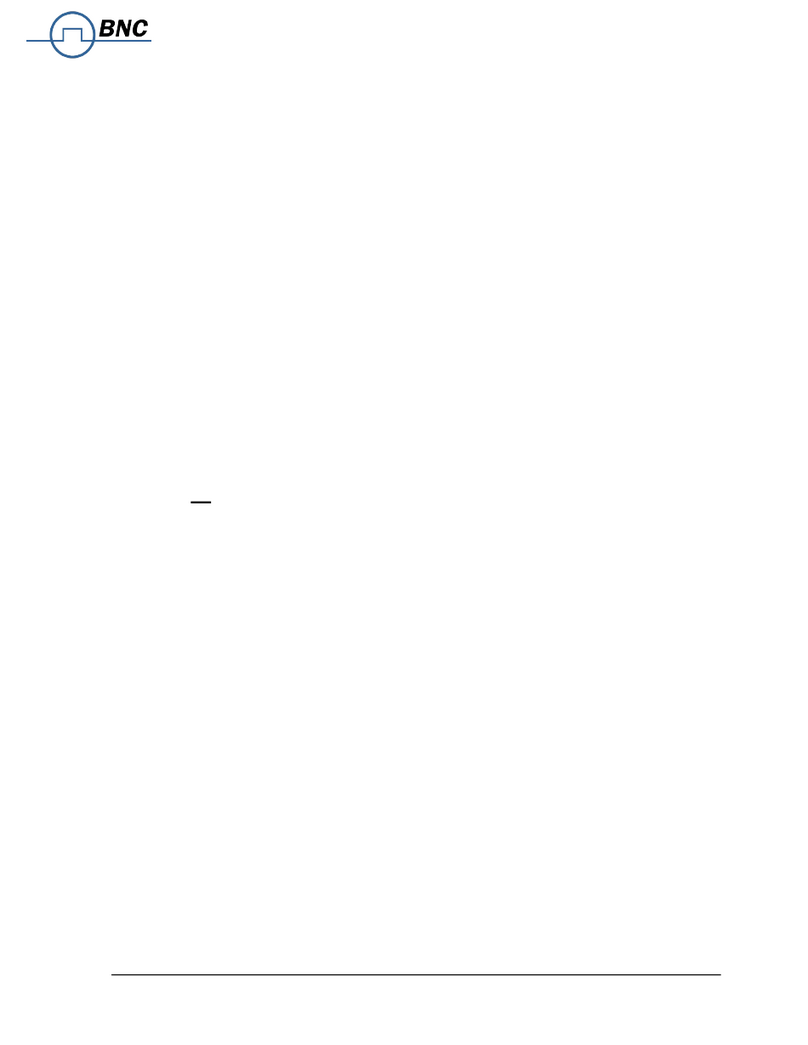
BNC
BNC 588 OEM-1NS user manual

Pyle
Pyle Power Inverter PNVU400 owner's manual
NXP Semiconductors
NXP Semiconductors UM11603 user manual
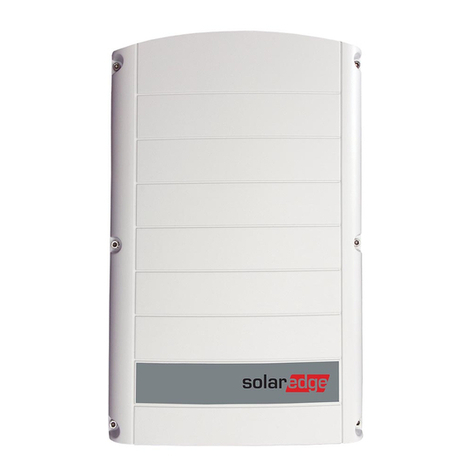
SolarEdge
SolarEdge SEK-AU I Series Quick installation guide
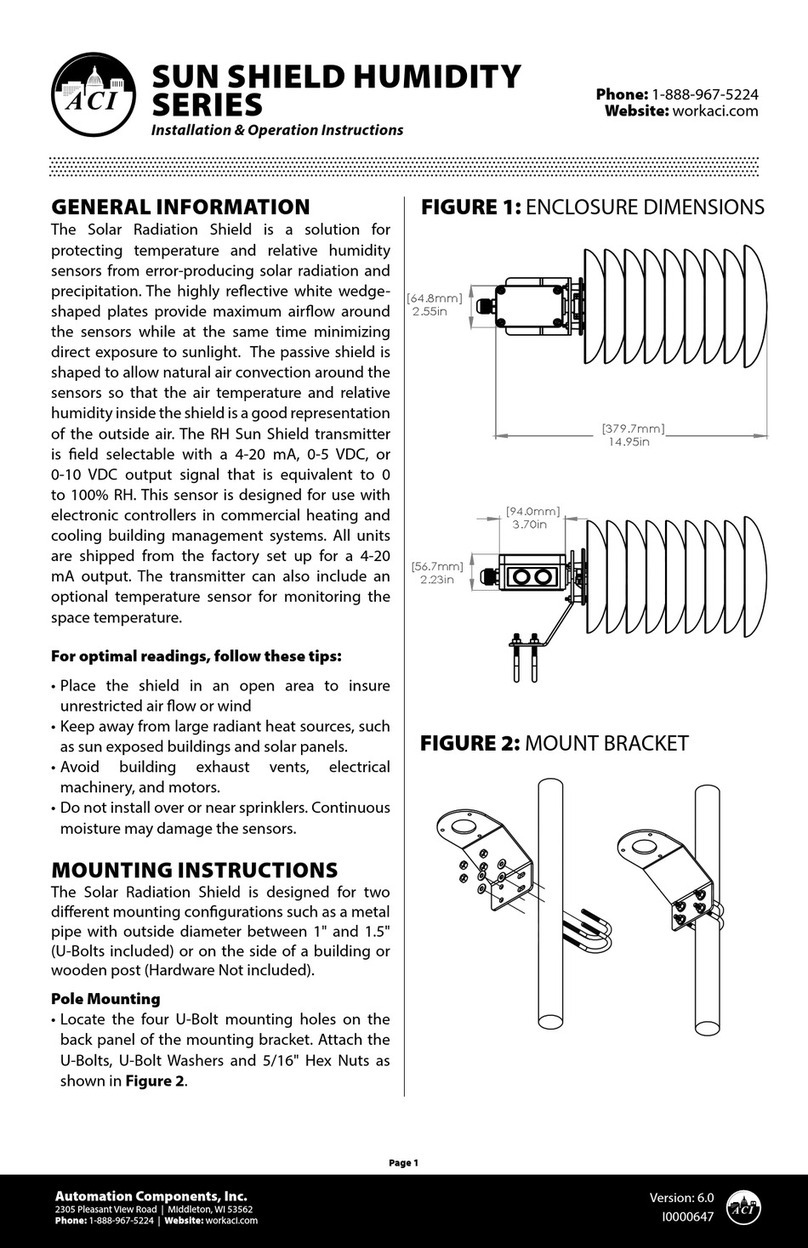
aci
aci SUN SHIELD HUMIDITY Series Installation & operation instructions
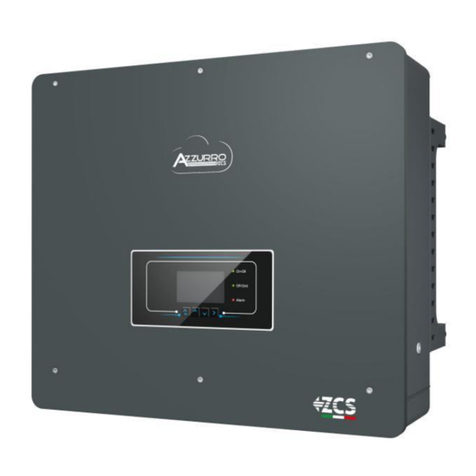
ZCS
ZCS Azzurro 3PH HYD5000 ZSS user manual
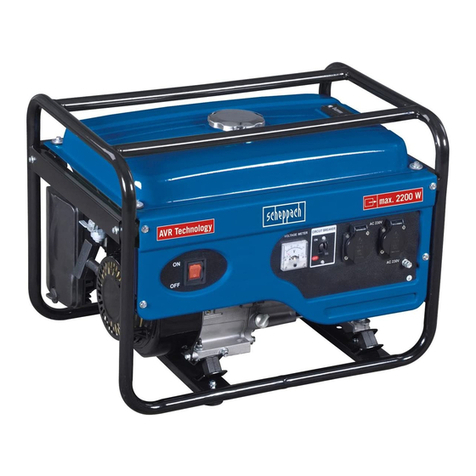
Scheppach
Scheppach SG2600 Translation from the original instruction manual
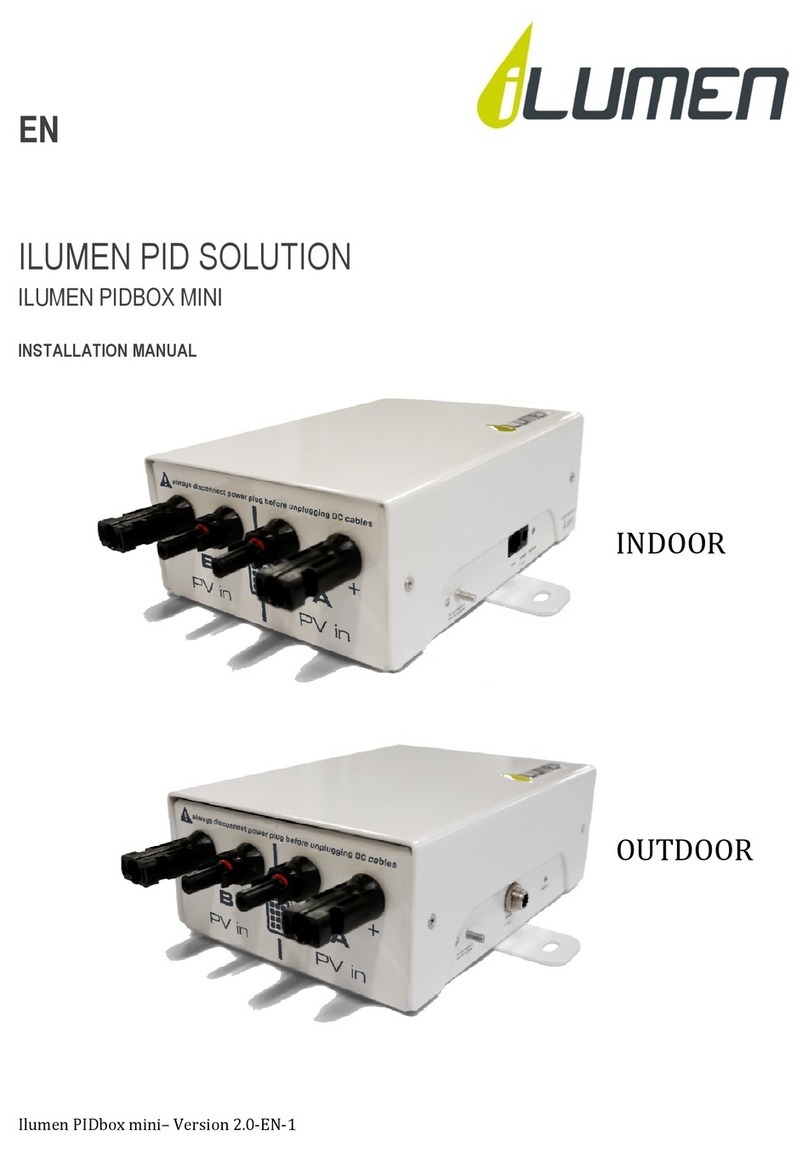
ILUMEN
ILUMEN PIDBOX MINI installation manual
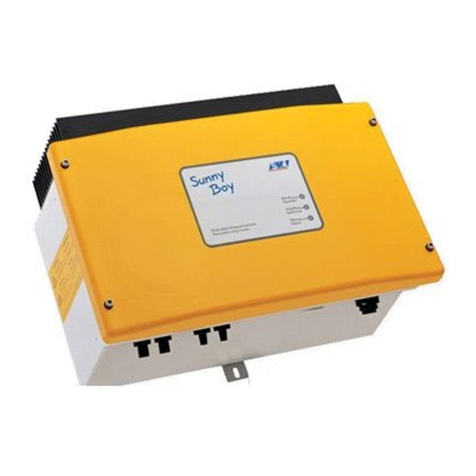
SMA
SMA SUNNY BOY 1700 installation guide
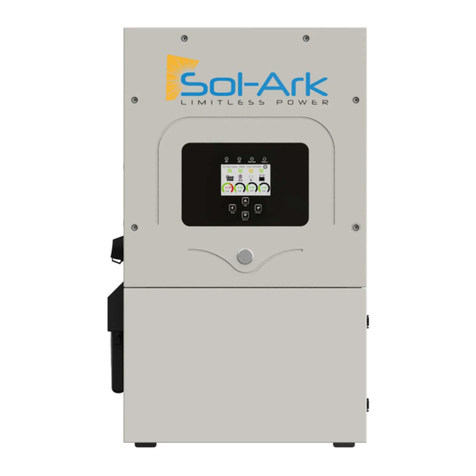
SimpliPhi Power
SimpliPhi Power Sol-Ark-8K Integration guide
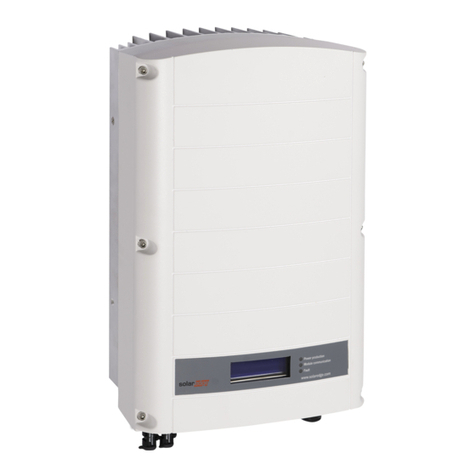
SolarEdge
SolarEdge SE3000 installation guide

